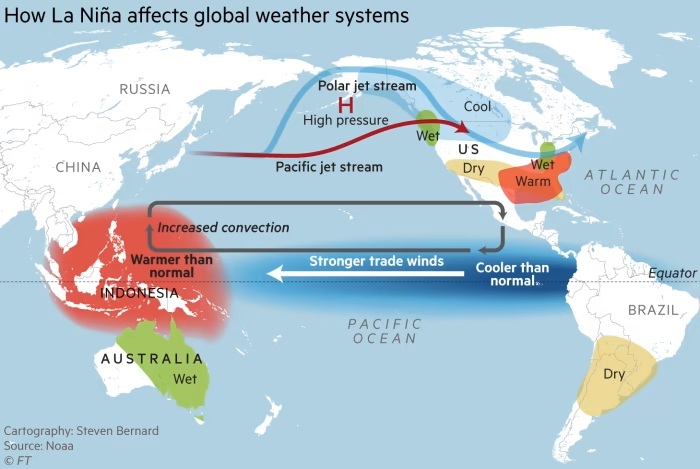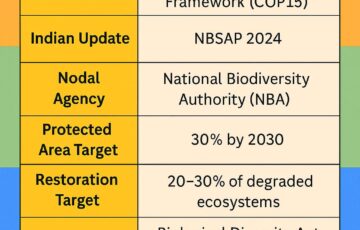La Niña’s Delayed Onset : Implications for Winter air quality
Syllabus:
GS-1:Important Geophysical PhenomenaPhysical GeographyWater Resources
Focus:
The delayed onset of La Niña raises concerns about deteriorating air quality in northern India this winter. With stubble burning and stagnant weather conditions expected to exacerbate pollution levels, experts are emphasising the need for comprehensive air quality management strategies.
Introduction to La Niña and Air Quality:
- Delayed Onset: The delayed onset of La Niña and the later retreat of the monsoon raise concerns about worsening air quality in north India this winter.
- Predictions of Pollution: Current projections suggest significant pollution-related challenges in early winter, particularly in November, even if stubble burning intensity is reduced.
- Previous Expectations: Initial forecasts had raised hopes for improved air quality due to anticipated La Niña conditions, which are typically associated with stronger monsoons and better rainfall.
- Research Findings: Recent studies by the National Institute of Advanced Sciences (NIAS) link climate change, La Niña, and air quality, highlighting the complexity of these interactions.
Understanding La Niña:
- Definition: Cooling of ocean surface, indicated by below-average sea surface temperatures (SST) in the central and eastern tropical Pacific, enhancing the cold Humboldt current.
- Impact:
- Increased rainfall in Indonesia and South Asia.
- Decreased rainfall in the central and eastern tropical Pacific.
- Strengthened normal easterly winds along the equator.
Triple Dip La Niña:
- Definition: A rare occurrence where La Niña conditions persist for three consecutive years.
- Recent Example: 2020-2023 marked a ‘triple dip’ La Niña, the first since 1998-2001.
Impact of Triple Dip La Niña in India:
- Resulted in above-normal, extended monsoon seasons.
- Example:
- Monsoon 2022 saw an all-India excess of 6% rainfall, extending into October.
- Increased extreme rainfall events, causing floods, flash floods, and landslides across various states.
Phenomenon of the El Niño Southern Oscillation (ENSO):
- Definition: ENSO is characterised by sea temperature changes in the tropical Pacific due to atmospheric fluctuations.
- Phases: Includes three phases—warm (El Niño), cool (La Niña), and neutral.
- Cycles: Occurs in irregular cycles lasting 2 to 7 years.
- Impact: Disrupts global air circulation and weather patterns, contributing to climate variability.
El Niño and La Niña:
- El Niño:
- Warm phase, spreading warmer water across the equatorial Pacific.
- More frequent than La Niña.
- La Niña:
- Cold phase, causing cooler water to spread in the same region.
- Both phenomena influence global weather, wildfires, ecosystems, and economies.
Latest Predictions and Impact on Indian Climate:
- La Niña Predictions:
- Recent La Niña episode (2020-2023); neutral phase predicted post-El Niño (June 2023-May 2024).
- Signs of La Niña expected by late September/early October, peaking in
- Indian Monsoon Impact:
- Delayed onset doesn’t guarantee poor monsoon performance; IMD predicts above-normal rainfall.
- Regional precipitation variations noted, especially in eastern and northeastern India.
- Northeast Monsoon:
- Runs from October to December, mainly affecting Tamil Nadu and southern India.
- La Niña typically does not favour this monsoon but exceptions exist.
- Cyclogenesis:
- Increased cyclone activity during La Niña years with higher intensity and longer life.
- Winter Effects:
- La Niña years may lead to harsher winters.
What is the Indian Ocean Dipole (IOD)?
- Definition: Changes in the sea surface temperature difference between the tropical western and eastern Indian Ocean.
Phases of IOD:
- Neutral IOD:
- Normal temperatures across the tropical Indian Ocean.
- Westerly winds blow along the equator.
- No significant impact on the Indian Southwest Monsoon.
- Positive IOD:
- Westerly winds weaken, moving warm water towards Africa.
- Cooler water rises in the eastern Indian Ocean.
- Increases moisture over the Arabian Sea, enhancing monsoon rainfall in India.
- Negative IOD:
- Westerly winds intensify, concentrating warm water in the eastern Indian Ocean.
- Warmer water in the east and cooler in the west.
- Adversely affects the Indian monsoon, resulting in below-average rainfall.
Shift in Perspective on Air Pollution:
- Changing Dynamics: Air pollution is no longer just a local issue but is influenced by broader meteorological and climatic factors, requiring a shift from emission-centric approaches.
- Atmospheric Circulations: Large-scale atmospheric phenomena, such as El Niño Southern Oscillation (ENSO), affect local air quality, necessitating a comprehensive understanding of these dynamics.
- Impact of Climate Change: There is growing evidence that extreme air pollution events are linked to climate change, emphasising the need for rigorous mitigation strategies.
Air Quality Outlook for Winter:
- Concerns for Delhi: The NIAS-SAFAR model indicates a concerning air quality outlook for Delhi due to delayed monsoon retreat and anticipated weather patterns.
- Humidity and Pollution: A slower monsoon withdrawal could result in prolonged high humidity and stagnant winds, trapping pollutants close to the ground.
- La Niña’s Role: The anticipated late onset of La Niña could limit wind dynamics, exacerbating pollution issues in northern India.
Stubble Burning and Its Effects
- Influence on Air Quality: In the absence of La Niña, stubble burning in neighbouring states like Punjab and Haryana is likely to significantly worsen air quality in Delhi.
- Potential Improvements: If La Niña develops in December, it could lead to stronger winds and clearer skies, slightly improving air quality later in the winter.
- Longer Winters: However, La Niña could also result in more severe winters, lowering the inversion layer that traps pollutants, thus complicating overall air quality improvement.
The Need for Comprehensive Strategies:
- Reevaluation of Policies: The findings underscore the importance of addressing larger airsheds rather than focusing solely on individual urban areas for effective air quality management.
- Health-Centric Measures: It is crucial to prioritise health-centric air quality measures through a scientifically informed resource framework, leveraging insights from research institutions.
- Integrated Approach: Collaboration between scientific bodies and policymakers is essential to develop strategies that address the complexities of air quality impacted by climate change and regional emissions.
Impact of La Niña on Meteorological Patterns:
- Delayed Weather Patterns: La Niña’s late onset affects seasonal weather dynamics, leading to unusual patterns in humidity and wind.
- Stagnant Winds: Prolonged neutral conditions may result in stagnant surface winds, trapping pollutants near the ground.
- Increased Humidity: The slower withdrawal of the monsoon could extend periods of high humidity, exacerbating air pollution levels.
- Air Quality Deterioration: Lower atmospheric mixing during the post-monsoon period may lead to elevated levels of 5 and PM10 in the air.
- Regional Influence: Pollutants from neighbouring regions, including stubble burning, can accumulate, worsening local air quality.
- Delayed Improvement: While La Niña could eventually improve air quality, initial conditions may remain hazardous due to existing pollution.
- Complex Interactions: The interplay between local emissions and broader climatic factors requires sophisticated modelling to predict air quality outcomes.
Policy Recommendations for Effective Air Quality Management:
- Integrated Policy Framework: Develop policies addressing both local emissions and broader climatic influences on air quality.
- Focus on Large Airsheds: Implement strategies that consider larger airsheds instead of just urban centres to improve air quality.
- Public Awareness Campaigns: Educate citizens about the links between climate change, air quality, and health to foster community engagement.
- Strengthening Regulations: Enforce stricter regulations on emissions from fossil fuels and agricultural practices, particularly stubble burning.
- Investment in Research: Fund research initiatives that explore innovative solutions for mitigating air pollution in the context of climate change.
- Health-Centric Approaches: Prioritise public health in air quality strategies, emphasising measures that reduce exposure to harmful pollutants.
- Collaborative Efforts: Encourage collaboration between governmental bodies, scientific institutions, and local communities to create effective air quality management plans.
Conclusion:
The delayed onset of La Niña presents significant challenges for air quality in northern India this winter. Effective management strategies must address not only local emissions but also larger climatic factors to mitigate pollution and protect public health in the face of evolving environmental conditions.
Source: The Indian Express
Mains Practice Question:
Analyse the implications of climate change and delayed meteorological phenomena like La Niña on air quality in northern India. What strategies should be implemented to address these challenges while focusing on public health? (250 words)





